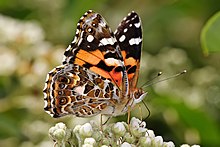Behaviour
Behaviour
Butterflies feed primarily on nectar from flowers. Some also derive nourishment from pollen,[58] tree sap, rotting fruit, dung, decaying flesh, and dissolved minerals in wet sand or dirt. Butterflies are important as pollinators for some species of plants. In general, they do not carry as much pollen load as bees, but they are capable of moving pollen over greater distances.[59] Flower constancy has been observed for at least one species of butterfly.[60]
Adult butterflies consume only liquids, ingested through the proboscis. They sip water from damp patches for hydration and feed on nectar from flowers, from which they obtain sugars for energy, and sodium and other minerals vital for reproduction. Several species of butterflies need more sodium than that provided by nectar and are attracted by sodium in salt; they sometimes land on people, attracted by the salt in human sweat. Some butterflies also visit dung and scavenge rotting fruit or carcasses to obtain minerals and nutrients. In many species, this mud-puddling behaviour is restricted to the males, and studies have suggested that the nutrients collected may be provided as a nuptial gift, along with the spermatophore, during mating.[61]
In hilltopping, males of some species seek hilltops and ridge tops, which they patrol in search for females. Since it usually occurs in species with low population density, it is assumed these landscape points are used as meeting places to find mates.[62]
Butterflies use their antennae to sense the air for wind and scents. The antennae come in various shapes and colours; the hesperiids have a pointed angle or hook to the antennae, while most other families show knobbed antennae. The antennae are richly covered with sensory organs known as sensillae. A butterfly's sense of taste is coordinated by chemoreceptors on the tarsi, or feet, which work only on contact, and are used to determine whether an egg-laying insect's offspring will be able to feed on a leaf before eggs are laid on it.[63] Many butterflies use chemical signals, pheromones; some have specialized scent scales (androconia) or other structures (coremata or "hair pencils" in the Danaidae).[64] Vision is well developed in butterflies and most species are sensitive to the ultraviolet spectrum. Many species show sexual dimorphism in the patterns of UV reflective patches.[65] Colour vision may be widespread but has been demonstrated in only a few species.[66][67] Some butterflies have organs of hearing and some species make stridulatory and clicking sounds.[68]
Many species of butterfly maintain territories and actively chase other species or individuals that may stray into them. Some species will bask or perch on chosen perches. The flight styles of butterflies are often characteristic and some species have courtship flight displays. Butterflies can only fly when their temperature is above 27 °C (81 °F); when it is cool, they can position themselves to expose the underside of the wings to the sunlight to heat themselves up. If their body temperature reaches 40 °C (104 °F), they can orientate themselves with the folded wings edgewise to the sun.[69] Basking is an activity which is more common in the cooler hours of the morning. Some species have evolved dark wingbases to help in gathering more heat and this is especially evident in alpine forms.[70]
As in many other insects, the lift generated by butterflies is more than can be accounted for by steady-state, non-transitory aerodynamics. Studies using Vanessa atalanta in a wind tunnel show that they use a wide variety of aerodynamic mechanisms to generate force. These include wake capture, vortices at the wing edge, rotational mechanisms and the Weis-Fogh 'clap-and-fling' mechanism. Butterflies are able to change from one mode to another rapidly.[71]


Comments
Post a Comment